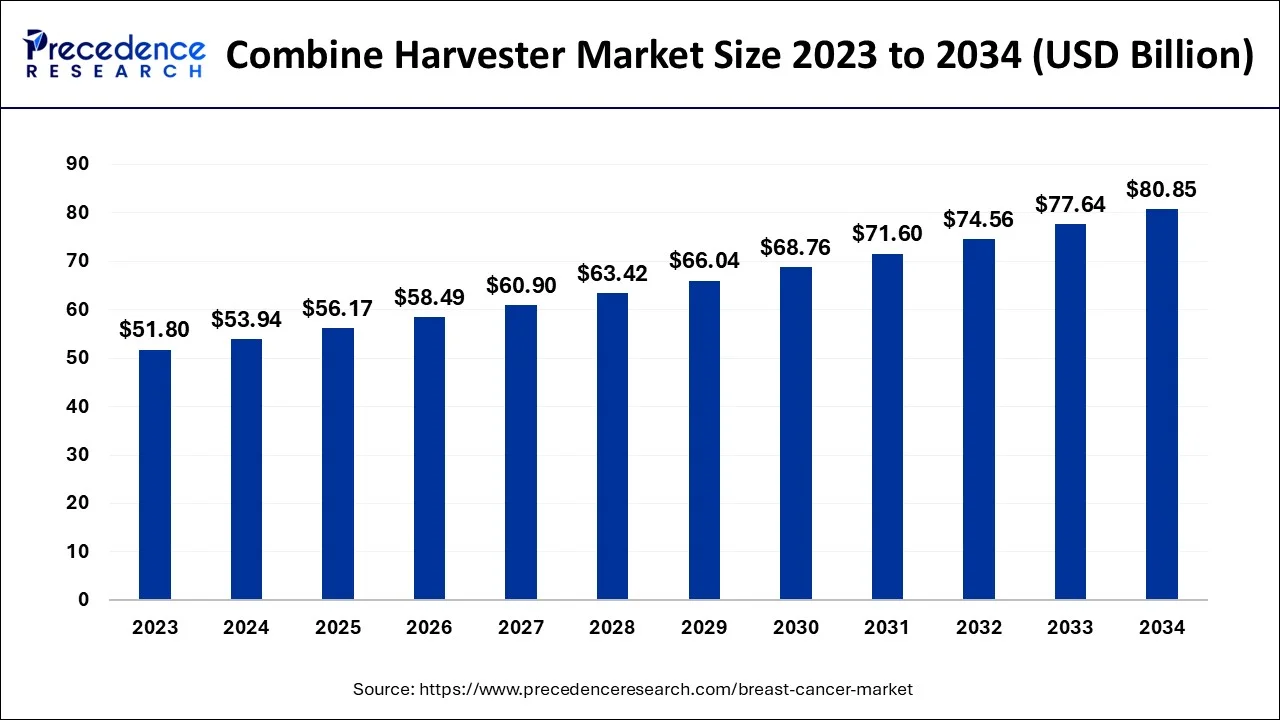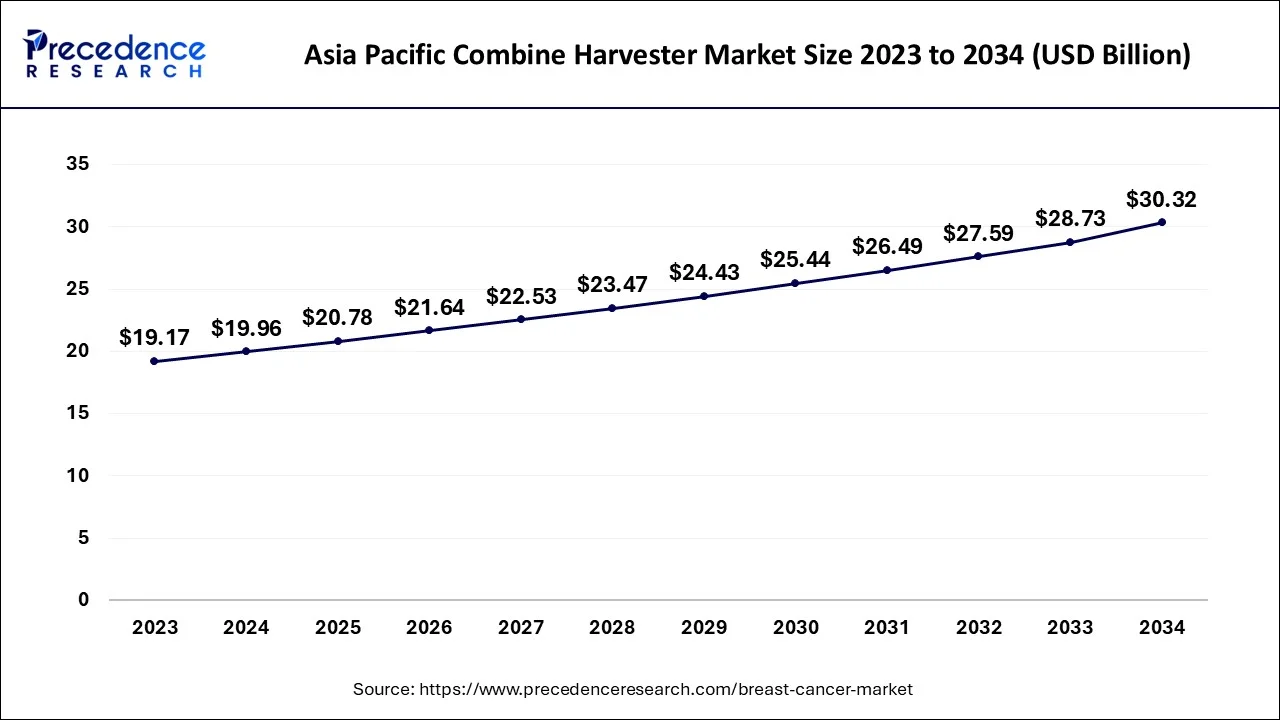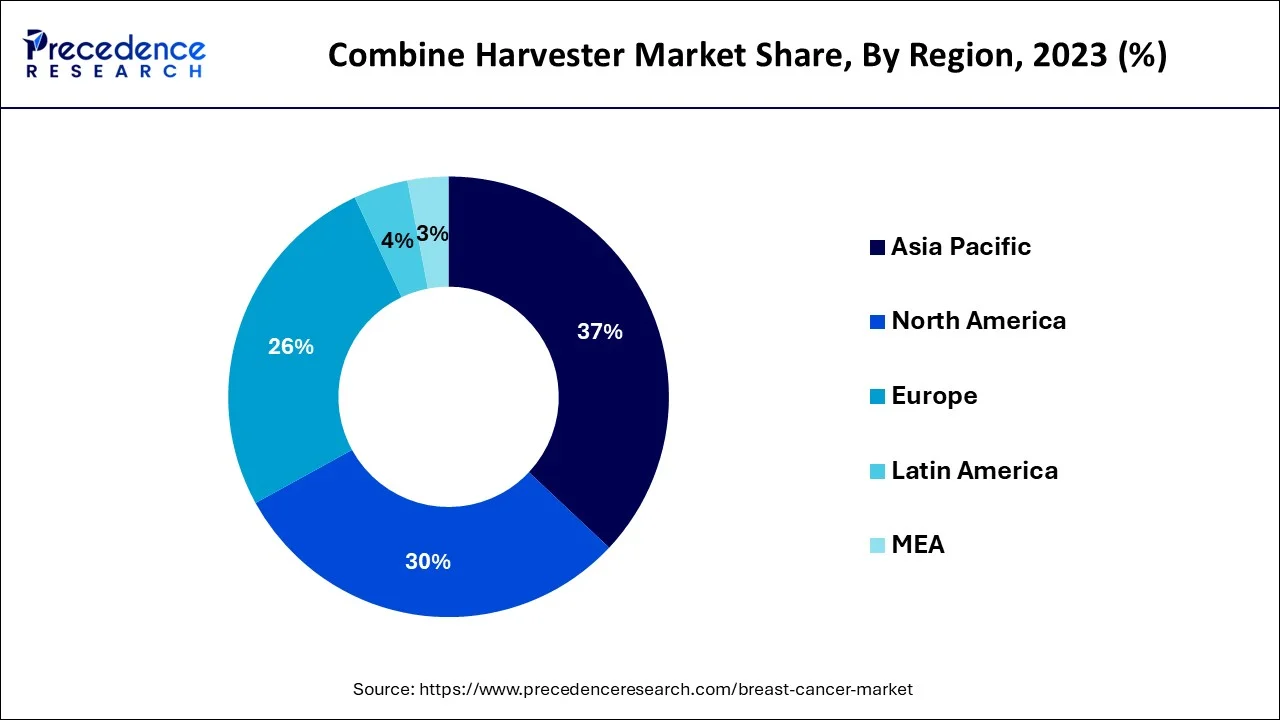List of Contents
Combine Harvester Market Size and Forecast 2025 to 2034
The global combine harvester market size was estimated at USD 53.94 billion in 2024, and is projected to hit around USD 56.17 billion by 2025, and is anticipated to reach around USD 80.85 billion by 2034, expanding at a CAGR of 4.13% between 2025 and 2034.

Combine Harvester MarketKey Takeaways
- In terms of revenue, the market is valued at $56.17 billion in 2025.
- It is projected to reach $56.17 billion by 2034.
- The market is expected to grow at a CAGR of 4.13% from 2025 to 2034.
- Based on type, the self-propelled segment held the majority of the market in 2024.
- Based on the mechanism, the hydraulic segment led the market in 2024.
- Based on power, the 150-300 HP segment will grow at the highest CAGR
- Based on class, the classes 5-6 (9-12 kg/s) segment is anticipated to experience the maximum CAGR of 4% from 2025 to 2034.
- Based on grain tank size, the 250-350 bu segment will grow at the greatest CAGR from 2025 to 2034.
- Based on crop type, the wheat segment dominated the market with a market share of around 37% in 2024.
- Based on region, The Asia Pacific region is seeing a transition from manual to mechanized farming due to growing urbanization.
Asia Pacific Combine Harvester Market Size and Forecast 2025 to 2034
The asia pacific combine harvester market size is calculated at USD 120.78 billion in 2025 and is expected to be worth around USD 30.32 billion by 2034, growing at a CAGR of 4.26% between 2025 and 2034.

The Asia Pacific region is seeing a transition from manual to mechanized farming due to growing urbanization.Throughoutthe course of the forecast timeframe, the region's industry for agricultural machinery is anticipated to grow at a CAGR of 4.4%.

Market expansion is being fueled by extensive agricultural activity, increased acceptance of cutting-edge techniques in the area, government backing, and Due to the planned renewal of combined harvester stock within those regions, the industries in Europe and North America are expected to experience positive potential growth within the second quarter of the forecast timeframe. Due to developing agricultural technology over course of the projection year, it is expected that the Indian market would offer more chances.
The North America combined harvester market accounted for the largest market share in 2024, dominating the global market. The region is growing due to the increasing demand for combined harvesters to support and sustain large-scale farming practices. The lack of availability of skilled laborers, increasing potential of exports, and technological shifts in farming practices are again driving factors for the market's growth in the region. The agricultural sector has undergone a major shift over the past years, including modifications in cropping methods, power sources, and input applications that support productivity. As labor's bandwidth has seen a gradual decline, many farmers and seasonal growers are looking for equipment as a replacement, further propelling the growth of the combine harvesters' market in North America.
Market Overview
Powerful equipment called a combine harvest was made to convenient energy for various grain harvests. threshing, A combination harvester combines the three separate harvesting processes of threshing, reaping, and winnowing into such a single procedure. This is the most economically advantageous labor-saving innovation of the modern world, resulting in a decrease in manpower in agriculture. In India, relative to other crop kinds, cereals and grains are frequently harvested with agricultural machinery. Farmers prefer self-propelled combination harvesters over harvesters placed on tractors because of their great efficiency. Equipment for combine harvesters is utilized in many agricultural operations, including reaping & threshing. A lot of time and money required for these tasks will be reduced with the usage of combined harvester equipment.
Combine Harvester Market Growth Factors
A versatile technology, the combines harvester is employed to efficiently harvest a range of crops. It stands out for having flexible suspensions and broad tires having deep, open grooves. Enhanced agricultural automation is among the key reasons propelling the India Combined Harvester Industry's expansion. Precision farming reduces post-harvest wastage, reduces agricultural production expenses, and ultimately boosts crop productivity and farm profitability. It also reduces labor and time. Instruments that are usually attributed, to animals, and machines have all increased steadily.
The market is expanding due to the pro-machinery credit policies of the federal government as well as other organizations, as well as the ability to boost farm output. An Indian government was enticing farmers to use technological innovations that would boost output. The need for combined harvesters would rise as people become more aware of new technologies and as farmers get more knowledgeable about production methods. This will help the sector keep its upward trajectory steady. Government initiatives, including those that offer incentives for purchasing equipment, also contribute to this growth. Farms are often small in scale, which prohibits the employment of large machinery there. This significantly reduces the requirement for combined harvester equipment.
The demand for combination harvester machinery is also anticipated to be severely constrained by their high maintenance and cost requirements. Because there was an excess of labor, labor prices were cheap, and machine expenses were high, the usage of combine harvesters had traditionally been restricted. Nevertheless, rural job programs like MGNREGA have improved the situation for combination harvesters in India. Beyond providing a social security net, the Gandhi National Rural Job Guarantee Act also protects the right to employment. Indian farmers now find it more cost-effective to use a machine for chopping and thrashing due to a shortage of labor with rising costs of labor.
Market Scope
| Report Coverage | Details |
| Market Size by 2034 | USD 80.85 Billion |
| Market Size in 2025 | USD 56.17 Billion |
| Market Size in 2024 | USD 53.94 Billion |
| Growth Rate from 2025 to 2034 | CAGR of 4.13% |
| Base Year | 2024 |
| Forecast Period | 2024 to 2034 |
| Segments Covered | Type, Mechanism, Power, Class, Grain Tank Size, Crop Type, and Region |
| Regions Covered | North America, Europe, Asia-Pacific, Latin America and Middle East & Africa |
Market Dynamics
Drivers
A growing need for cutting-edge modern farm equipment
- One of the main reasons propelling the industry for combine harvesters is the growing need for modern farm equipment on a global scale. Farm mechanization increases crop yield & farm profit by cutting crop manufacturing costs overall, minimizing post-harvest wastage, and conserving labor and time.
- The demand for transporting goods by electrical and mechanical sources of power, along with hand-operated equipment & animal-driven tools, has risen as more people are becoming aware of their advantages. Around the globe, the GDP of every country is significantly influenced by the agriculture industry. The market for agricultural machinery is also being fueled by authorities' efforts to improve their agriculture activities across both emerging and developed countries.
Support from the government for agricultural technology
- Governments from all around the world occasionally provide combine harvesters with varied subsidies. And over 60 indirect and direct farmers and support programs are managed by the Agriculture Department of the United States. with the most of direct assistance going to growers of a select few commodities, like those growing maize, soybean, as well as wheat. Insurance, farming advanced financial, price drop coverage, conservation efforts, advertising financing, and emergency assistance.
- The market's expansion is also aided by technology and other incentives. The Agriculture Infra Fund (AIF) is established to generate a medium to long-term commercial loan facility for investments in post-harvest infrastructure systems using incentive and financial assistance to enhance the US agricultural network.
Key Market Challenges
- Total Manufacturing Costs for Farm Equipment: In recent decades, combination harvest tractor designs have changed in response to shifting customer expectations. Modernization equipment design, though, necessitates significant development and research expenditures, which may increase the final product's cost. Although product efficacy is crucial to farmers, affordability is often the most crucial component, particularly in developing and emerging nations. Combination harvesters have become increasingly complicated in recent times, making operations considerably more challenging.
Key Market Opportunities
- Labor Shortage and Increasing Farm Labor Costs: Fruits, peas, vegetables, and beans were lying unplanted throughout states as a consequence of a labor crisis that is impacting American farmers throughout 2020 again for the fourth time in a row. Vegetables and fruits are now being transported to meet demand because of the shortfall. American farmers are embracing several cutting-edge strategies to expand their businesses while utilizing limited workers. Farmers are adopting agrotechnology, like sensors, forecast accuracy, automation, and robotics, despite their expensive initial costs, to improve crop yield and quality to order to operate effectively using limited resources.
Type Insights
Self-propelled vehicles held the majority of the market in 2024, and throughout the forecast timeframe, they are anticipated to grow at the fastest CAGR. Wheeled extractors are fantastic for fields with rough soil. They represent the standard type that is popular in India and Bangladesh. Since of their great efficiency and low maintenance issues, self-propelled combination harvesters are expanding. In tiny farm fields, vehicles and agricultural machinery are frequently preferred range sizes from 1-10 acres.
Mechanism Insights
The market was led by hydraulic agricultural machinery in 2024, but over the projected timeframe, hybrid combined harvesters are anticipated to grow at the fastest rate. The header serves as the primary control panel for the tractor. The hydraulic drivetrain of a header has a direct effect on both the machine's performance overall and the gearbox system's layout. Benefits of hydraulic management include a high density of power and small volume. Nevertheless, hybrid combination extractors may harvest the produce without no wastage and in a shorter time, especially on fields with evergreen trunks or moist areas.
Power Insights
Modern combine harvesters frequently have a diesel engine to operate all of the equipment's operational components and to move the machine forward when in use. The share of the market of agricultural machinery with 150–300 horsepower will grow at the highest CAGR, per the Astute Analytica analysis, although those with fewer horsepower would hold the majority of the market. Additionally, favorable for such a diesel car sector could be the increased accessibility of a large number of state-of-the-art diesel engine farming equipment.
Class Insights
While the classes 5-6 (9-12 kg/s) category is anticipated to experience the maximum CAGR of 4% and over a projected timeframe, the classes 3-4 (5-8 kg/s) sector held the largest share of the market throughout 2022. The quality and speed of performing a variety of actions determine the efficiency (output) of a harvesting machine. Although small tractors are much more maneuverable in smaller fields, wider engines were best adapted for large disciplines with light soil texture. Wider machines cannot operate in tiny paddy fields, discouraging their use by small proprietors. Due to the abundance of little farming plots in India and Bangladesh mini combine extractors has recently grown in favor in South Asia.
Grain Tank Size Insights
It is anticipated that the 250-350 bu category will grow at the greatest CAGR throughout the projected period and have the largest market share in 20232. The growing demand for smaller tractors is responsible for the 250 bu sector's good future growth.
Crop Type Insights
With a market share of around 37% in 2024, the wheat category dominated. The category is anticipated to develop as a result of the persistently increasing demands for grains and the persistently rising emphasis on improving its productivity relative to certain other crops. To order to meet the growing demand from Southeast Asia, in addition to Europe, Western Asia, with Northern Africa, India, the 2 exporters of wheat within the globe, is concentrating on mechanizing the agriculture industry more broadly. Due to the growing demand for the wheat harvesting process within the Asia Pacific, imports from Ukrainian have already been hindered since Russia's intervention in Feb 2022.
Combine Harvester Market Companies
- Claas KGaA GmbH
- CNH Industries NV
- Deere & Company
- Farm Equipment Limited
- Hind Agro Industries
- Iseki & Co. Ltd
- Kartar Agro Industries Private Limited
- KS Group
- Kubota Agricultural Machinery
- LOVOL
- Mahindra & Mahindra Limited
- Massey Ferguson (AGCO Corporation)
- New Holland
- Preet Group
- Renault Sonalika International
- Sampo Rosenlew Ltd.
- SDF S.p.A.
- Tractors and Farm Equipment Limited (TAFE)
- Yanmar Co. Ltd
Recent Developments
- In May 2024, the axial-flow 260 series was developed and launched by leading marketer Case IH, which is a brand of CNH. It offers an excellent productivity rate for custom harvesters and farmers. With the help of single-Rotar case IH harvesting technology, maximum yield and efficient grain handling are possible. (Source: https://www.agweb.com)
- In February 2024, industry leader John Deere launched a new 9RX tractor model with a horsepower of 830 hp, marking a pivotal moment for farmers dealing with changing weather patterns, a labor shortage, and increasing input costs. This model promises to offer high high-horsepower four-wheeler tractor that helps transform farming practices, including preparation, planting, harvesting methods, and others. (Source: https://www.news-jd.com)
- In July 2024, a leading player, CLAAS, launched LEXION 8900 TERRA TRAC in Canada at the motion farm show. This is a top model among the LEXON models, having 779 max horsepower with efficient engine power of 16.2 MAN engine having dynamic power. (Source: https://www.marketbook.ca)
- Agricultural technology company Bear Flag Robotics, situated in Silicon Valley, was bought by John Deere in August 2021. This acquisition will increase John Deere's agricultural equipment mechanization and assist their long-term objective of developing cutting-edge machinery to meet the needs of specific customers.
- To achieve high performance, CLAAS KGaA mbH added the brand-new CONVIO FLEX as well as CONVIO draper cutting bars to its product lineup in August 2018.
- Massey Ferguson, a brand of AGCO Corporation, announced the launch of RazorEdgeTM 1300 Model Pull-Type Discs Mower Conditioners in 2018.
- Kubota Company began full-scale operations at a new tractor and wheel-type combined harvester manufacturing facility in Nov 2017. The business provides a variety of agriculture products, and its well-known harvester PRO1408Y produces excellent performance.
- The updated Swaraj Pro Combined 7060, a track combine from the Swaraj product series, was unveiled in Sept 2021 by Mahindra and Mahindra Ltd. This new Swaraj Professional Combine 7060 has a modified paddy cutter bar and can efficiently as well as accurately cut sleeping plants at a lower cost.
Segments covered in the report
By Type
- Self-propelled
- Tractor-pulled Combine
- PTO-powered Combine
By Mechanism
- Hydraulic
- Hybrid
By Power
- Below 150 HP
- 150-300 HP
- 300-450 HP
- 450-550 HP
- Above 550 HP
By Class
- Class 1-2 (0.5-3 Kg/s)
- Class 3-4 (5-8 Kg/s)
- Class 5-6 (9-12 Kg/s)
- Class 7 (12-14 Kg/s)
By Grain Tank Size
- <250 bu
- 250-350 bu
- >350 bu
By Crop Type
- Wheat
- Corn
- Rice
- Others
ByGeography
- North America
- Europe
- Asia-Pacific
- Latin America
- The Middle East and Africa
For inquiries regarding discounts, bulk purchases, or customization requests, please contact us at sales@precedenceresearch.com
Frequently Asked Questions
Ask For Sample
No cookie-cutter, only authentic analysis – take the 1st step to become a Precedence Research client